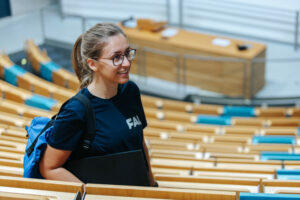What skills should you bring?
What are the admission requirements?
Communications and Multimedia Engineering (CME) is a challenging, research-oriented Master’s degree program. It is generally suitable for students with:

- a Bachelor’s degree in Engineering,
- a strong foundation in Engineering Mathematics, Signals and Systems, Communications, Stochastic Signals and skills in a programming language,
- above average grades,
- and excellent English language proficiency.
For more details on the fomal requirements that need to be fulfilled in order to be eligible for admission to our Master’s degree program CME, see the section “Application”.
Which qualities and skills do you need?
CME emphasizes fundamental concepts of modern technologies in the areas of signal processing and communications. In order to benefit from our demanding Master’s program, you need to possess excellent education in these fields at the Bachelor’s level, encompassing both theoretical understanding and programming skills for practical applications.
In particular, you need a strong foundation and working knowledge in the following fields:
- Engineering Mathematics: linear algebra, complex analysis, linear differential equations, Fourier transform, Laplace transform, z-transform, probability and random variables
- Signals and Systems (e.g., A. V. Oppenheim and A. S. Willsky, Signals and Systems, Pearson Education Limited, 2nd ed., 2013)
- Communications (e.g., S. Haykin and M. Moher, Communication Systems, Wiley, 5nd ed., 2009)
- Stochastic Signals (e.g., A. Papoulis and S. U. Pillai, Probability, Random Variables and Stochastic Processes, McGraw-Hill Professional, 4th ed., 2002)
- Skills in a programming language such as C/C++, MATLAB, and Python (e.g., M. Müller and S. Rosenzweig, PCP notebooks: A preparation course for Python with a focus on signal processing, Journal of Open Source Education (JOSE), 5 (2022), pp. 148:1-5)
Are you ready for the CME challenge?

If you can easily answer the following example questions, CME could be the perfect program for you:
- What is the rank and trace of a matrix? What are eigenvalues and eigenvectors?
- How can one determine the maximum or minimum of a differentiable function?
- What is a gradient? What is the idea behind gradient descent?
- What is an LTI system, and how can it be characterized in the time and frequency domains?
- What does the Nyquist-Shannon sampling theorem say?
- How does the Fast Fourier Transform work? What is its runtime?
- How are the discrete-time Fourier transform (DTFT) and the discrete Fourier transform (DFT) connected to each other?
- What is the essential property of white noise?
- How are the concepts of stationarity and ergodicity of a stochastic process defined?
- Which digital modulation scheme would you select for the transmission of 4 bit per modulation interval?
- What are the most commonly used pulse shaping filters in digital modulation?
- Which tasks have to be performed in a digital communications receiver?
- What is the objective of source coding and channel coding, respectively?
- Give some examples for source and channel coding schemes.
- Which kind of information do entropy and channel capacity, respectively, provide?
- What are the main channel impairments in wireless communications?